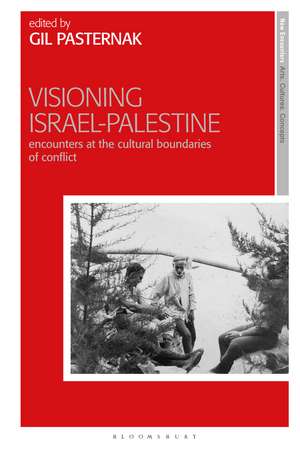Visioning Israel-Palestine: Encounters at the Cultural Boundaries of Conflict: New Encounters: Arts, Cultures, Concepts
Editat de Dr Gil Pasternaken Limba Engleză Hardback – 22 iul 2020
| Toate formatele și edițiile | Preț | Express |
|---|---|---|
| Paperback (1) | 200.36 lei 6-8 săpt. | |
| Bloomsbury Publishing – 23 feb 2022 | 200.36 lei 6-8 săpt. | |
| Hardback (1) | 604.49 lei 3-5 săpt. | |
| Bloomsbury Publishing – 22 iul 2020 | 604.49 lei 3-5 săpt. |
Preț: 604.49 lei
Preț vechi: 862.12 lei
-30% Nou
Puncte Express: 907
Preț estimativ în valută:
115.68€ • 120.62$ • 96.14£
115.68€ • 120.62$ • 96.14£
Carte disponibilă
Livrare economică 27 februarie-13 martie
Preluare comenzi: 021 569.72.76
Specificații
ISBN-13: 9781501364624
ISBN-10: 1501364626
Pagini: 336
Ilustrații: 47 bw illus
Dimensiuni: 156 x 234 x 28 mm
Greutate: 0.86 kg
Editura: Bloomsbury Publishing
Colecția Bloomsbury Visual Arts
Seria New Encounters: Arts, Cultures, Concepts
Locul publicării:New York, United States
ISBN-10: 1501364626
Pagini: 336
Ilustrații: 47 bw illus
Dimensiuni: 156 x 234 x 28 mm
Greutate: 0.86 kg
Editura: Bloomsbury Publishing
Colecția Bloomsbury Visual Arts
Seria New Encounters: Arts, Cultures, Concepts
Locul publicării:New York, United States
Caracteristici
While the current volume pays specific attention to the case of Israel-Palestine, the fact that similar types of challenges and problems recur in the context of the cultures and cultural politics of other conflicts suggests that its approach to cultural products may be employed to study other cultures of conflict, and the studies it features can be used for comparative scholarship
Notă biografică
Gil Pasternak is Reader in Social and Political Photographic Cultures in the Photographic History Research Centre (PHRC) at De Montfort University, United Kingdom. A member of the advisory board for the journals Photography & Culture and Jewish Film & New Media, earlier in life he worked as a photojournalist, photography archivist and fine art photographer.
Cuprins
List of Illustrations Acknowledgements Series Preface-New Encounters: Arts, Cultures, Concepts Griselda Pollock Introduction: Encounters at the Cultural Boundaries of Conflict Gil Pasternak PART I: PRODUCTS OF CONFLICT 1 A Country as a Map of Itself: On the Historical, Cultural and Theoretical Rendering of Palestine in Sobhi al-Zobaidi's Part-ition (2008) Abdul-Rahim Al-Shaikh 2 Laughter 'In Between' Time: Temporality, Iconography, and the Burden of Proof in Palestinian Art After Oslo Chrisoula Lionis 3 Impossible Intimacies: Towardsa Visual Politics of 'Touch' at the Israeli-PalestinianBorder Anna Ball 4 Dreams or Nightmares: The Artworking of Return in And Europe will be Stunned (2007-11) by Yael Bartana (with Slawomir Sierakowski) Griselda Pollock PART II: PRODUCTS IN CONFLICT 5 Scandal! Images, Discourses, and the Image of Discourse that 'Hurt People's Feelings' Rhoda Rosen and Sander L. Gilman 6 Showcasing Conflict: Notes and Observations on Photographic Representation in Israel and Palestine Huw Wahl 7 Visibility, Photography, and the Occupation: The Case of The Activestills Collective Simon Faulkner 8 At Home with 'Palestine': Performing Photographs of the West Bank in Israeli Households Gil Pasternak 9 Postmemory and Oral History: Intergenerational Memory and Transnational Identity in Exile Ihab Saloul Appendix Invention, Memory, and Place Edward W. Said Notes Bibliography List of Contributors Index
Recenzii
This rich volume introduces the inspiring neologism "visioning" to make the hyphen between Israel-Palestine a sign of bonding and correlation instead of its common perception as a sign of distance and separation. Chapter-by-chapter it brilliantly demonstrates Gil Pasternak's conviction that the arts matter to the future of Israelis and Palestinians - a conviction which I share.
This innovative volume draws on a wide range of aesthetic sources to show how cultural products can review and reframe the Israeli-Palestinian conflict. We can then see that visual art, broadly understood, not only engages past trauma but also opens up possibilities for a more peaceful future.
The title of this remarkable collection telegraphs its fundamental message. A hyphenated "state" (in the sense of an actual condition rather than a political entity) already exists in Israel, Gaza, and the West Bank. This state is a fragmented jigsaw puzzle of cooperation and conflict, inequality and co-presence that eludes all one-sided nationalist narratives, most notably the long-imagined "two state solution" which now belongs in the dustbin of history. Focusing on "cultural products" (images, texts, exhibitions, films, and stories), Visioning Israel-Palestine provides an account of contemporary experiences and encounters that promise to assemble this puzzle as a compellingly legible mosaic.
The refreshing premise of this volume is the recognition that there exists an interculturality within Israeli and Palestinian works of art based on the conflict they share. ... Visioning Israel-Palestine succeeds in making clear that art and culture will remain central in chipping away at the ossified dash that has bound 'Israel' and 'Palestine' in conflict for over half a century.
This innovative volume draws on a wide range of aesthetic sources to show how cultural products can review and reframe the Israeli-Palestinian conflict. We can then see that visual art, broadly understood, not only engages past trauma but also opens up possibilities for a more peaceful future.
The title of this remarkable collection telegraphs its fundamental message. A hyphenated "state" (in the sense of an actual condition rather than a political entity) already exists in Israel, Gaza, and the West Bank. This state is a fragmented jigsaw puzzle of cooperation and conflict, inequality and co-presence that eludes all one-sided nationalist narratives, most notably the long-imagined "two state solution" which now belongs in the dustbin of history. Focusing on "cultural products" (images, texts, exhibitions, films, and stories), Visioning Israel-Palestine provides an account of contemporary experiences and encounters that promise to assemble this puzzle as a compellingly legible mosaic.
The refreshing premise of this volume is the recognition that there exists an interculturality within Israeli and Palestinian works of art based on the conflict they share. ... Visioning Israel-Palestine succeeds in making clear that art and culture will remain central in chipping away at the ossified dash that has bound 'Israel' and 'Palestine' in conflict for over half a century.














